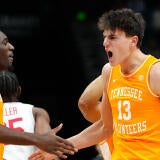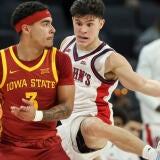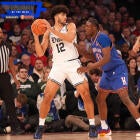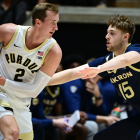Players Era format needs to be tweaked in order for event to reach its full potential in 2026 and beyond
Michigan will face Gonzaga in the finals of the Players Era in Las Vegas, but how they got there created some confusion
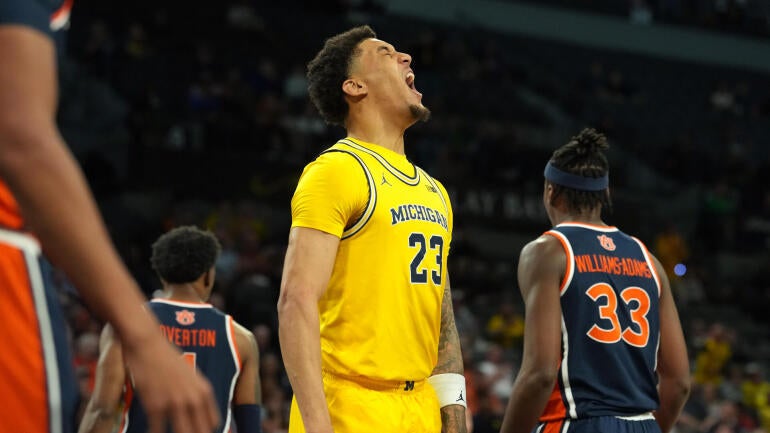
LAS VEGAS — When a sporting event's format becomes a bigger story than the actual games, you've got a problem.
And for the moment, the Players Era has a problem. An image problem at least. A comprehension problem.
After two days of some really good basketball, here's what awaits on Wednesday:
- No. 7 Michigan vs. No. 12 Gonzaga (championship game)
- No. 17 Tennessee vs. Kansas (third-place game)
That's a terrific doubleheader, of course. The championship game will be for $1 million in additional NIL money, with $500,000 going to the loser. The Tennessee-Kansas winner will get another $300,000, with the loser getting $200,000.
Those four teams went 2-0 over the past two days.
But so did No. 15 Iowa State. But because of two plays and four points in two games 24 hours apart, Kansas will play for more money, while Iowa State will be boxed out. What's the Cyclones' reward? A game against 4-2 Syracuse at 10 a.m. local time on Wednesday.
Here's why that's happening.
Late buckets mattered
On Monday, St. John's Dillon Mitchell had a put-back as time expired to make Iowa State's win over the Red Storm 83-82 instead of 83-80. Then, on Tuesday, Kansas' win against Syracuse was well in hand and surely decided. With less than 30 seconds to go, KU's Kohl Risario threw down a slam to increase the lead from 69-60 to 71-60.
Kansas' point differential after two games was 21. Iowa State was 19.
That's why Kansas has an opportunity in a money game, while ISU gets what may well be a Quad 2 result vs. a Syracuse team that has played well here but still failed to win a game.
There are more reasons for teams to have gripes. Consider how Tennessee had to bludgeon its way past No. 3 Houston in what was almost certainly the most physically punishing game of the first two days. But the Vols don't get to play in the championship game for the most money because they were matched up with the highest-ranked opponent in the 18-team Players Era field.
It's all happening because of a statistical tiebreaker that's traditionally kept to the likes of high-profile soccer tournaments, where scoring is at a premium in that sport and pool play typically includes round-robin competition.
The Players Era doesn't apply to either of those scenarios, though.
"We do something different so actually you're not just watching the same thing you've been watching every November, just with more teams," co-founder Seth Berger said. "We're trying to bring November basketball to more casual fans, so clearly one of the things we have to do is continue educating about why our format is unique and it's exciting. In this format every shot matters, every basket matters, every minute matters."
I'll admit: Having every game and every basket matter is a concept that has some positives. It's different from traditional bracket play and brings on-court relevance to more games. But casual fans associate college basketball tournaments with brackets. It is the very essence of November basketball, let alone what March Madness is literally built upon.
Bracket play works.
And even though this is Year 2 for Players Era, it's effectively Year 1 because last season's eight-team event really didn't pierce the public consciousness.
So the PR rollout has been mixed. Most fans can't easily follow what's happening, even if the games have been good. (And plenty of them have.)
There's nothing that will be done about this year. The matchups were determined at 12:30 a.m. ET on Wednesday morning/9:30 p.m. PT, and if you've made it this far into my column wondering just who the heck is playing each other, this is Wednesday's schedule:
| Syracuse vs. No. 15 Iowa State | 1 p.m. (TNT) at Grand Garden Arena |
| Notre Dame vs. No. 3 Houston | 3:30 p.m. (TNT) at Grand Garden Arena |
| Third-place: Kansas vs. No. 17 Tennessee | 7 p.m. (TNT) at Grand Garden Arena |
| No. 14 St. John's vs. No. 21 Auburn | 8 p.m. (truTV) at Grand Garden Arena |
| Championship: No. 13 Gonzaga vs. No. 7 Michigan | 9:30 p.m. (TNT) at Grand Garden Arena |
| Baylor vs. San Diego State | 10:30 p.m. (truTV) at Michelob Ultra Arena |
| Maryland vs. No. 8 Alabama | 12 a.m. (TNT) at Grand Garden Arena |
We'll write, talk and react to all of Wednesday's games on Wednesday.
Format in flux
I want to stay on the larger issue, which is what to do about the format in the years ahead. Next year the event is going to 32 teams. It will be the biggest regular-season event in the history of college basketball. Those 32 teams will be split into four eight-team pools. From that, the four teams that win their pool play (against three other teams in predetermined matchups that will be made next offseason) will do so based on best record ... and then point differential/margin of victory as the decider.
"Those four teams will each play in one more game, a first-place game and a third-place game," Berger said Tuesday at a press conference here. "The system, over time, I think will be pretty simple and understandable to fans. What we're trying to do here, and I think it's an interesting question because for basketball fans or parents or coaches who have played in AAU events, this is relatively standard, this kind of happened every single weekend when you go to an event."
Berger and co-founder Ian Orefice have faced a lot of skepticism and backlash over their event because of its expensive and unprecedented nature. But they're doing good things for the players. More than 200 Division I athletes involved in this event are going to be paid significant money in NIL opportunities. It's a positive for the sport.
The next step is making sure the event can bring in fans and have a format that isn't hard to follow.
Keeping options open
A silver lining for anyone hoping the current format can switch to something more traditional: Orefice told me Tuesday night that it's not a certainty that the future of the event will be pool play that has to include point-differential tiebreakers.
"We're open to all feedback," Orefice said. "Nothing is 100% set moving forward. We're committed to four eight-team pools next year, almost definitely, but we'll see."
Orefice said they'll take in the opinions from every team in the event as they look to planning in 2026 and beyond. Orefice added that the primary goal — what they refer to as a "North Star" — is to make Players Era good as possible. Orefice made a point to say he Berger aren't going to act like they have all of the answers and be resistant to any type of change. They've created something that has upended the sport's November calendar — and it stands to be a behemoth in the years ahead, provided it put on an event that's TV-friendly, fan-friendly and easy to follow.
Asking fans to stay up late to find out matchups for every team less than 16 hours before the games will be played isn't great for fans — or coaches. I had one staff in this year's field text me after 8 p.m. local on Tuesday to ask if I had the scoop on who they were playing.
You never want that.
It's only Year 2 and the event will continue to evolve, but if it wants to reach its maximum potential as a sports entity, it would probably be best to determine a way to make bracket play the skeleton of Players Era moving forward. Make the wins and losses matter most — and not leave the style points as tiebreakers. If the event can get to that place in the next year or two, then it will truly be what the founders envisioned: a tournament that embodies the spirit of March Madness and all the good that comes with it.


